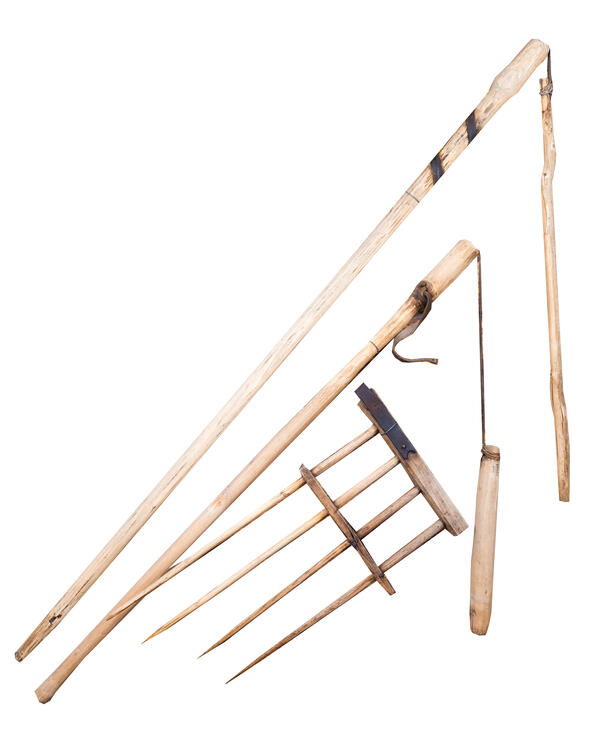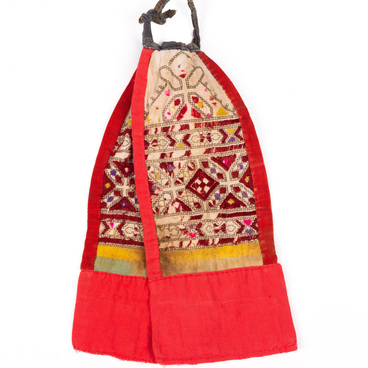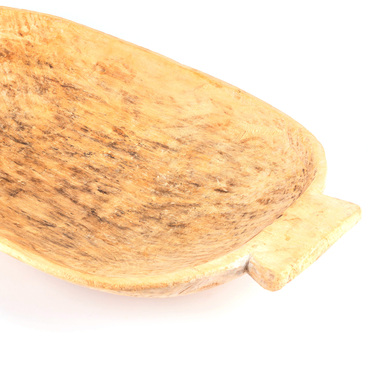Almost all peoples in Bashkortostan were involved in agriculture. In the western regions of Bashkiria, agriculture became the leading sector in the economy by the 18th century, and in the eastern parts by the end of the 19th century. To cultivate local lands, peasants used wheeled wooden plows (wooden plows called sabans), a harrow, and plows that had one plowshare - a sharp plowing tip. Useful crop species were sowed from a pail or basin. This was followed by harvesting, which consisted of several successive stages: harvesting, tying the sheaves together, threshing, winnowing, and drying.
During the harvest, the peasants used a variety of hand tools: sickles, scythes, shovels, and flails. Grain crops were reaped with scythes or sickles: if rye grew tall and thick, then the sickle was preferred, and low, sparse grain fields were reaped using scythes. The harvest was first gathered together into sheaves, and then in shocks - heaps of hay or sheaves stacked into the shape of a cone. Drying was accomplished in special-purpose facility areas or drying barns. The next stage of processing the crops was threshing, which was done either by hand or with help from horses.
Grain threshing is the process of separating seeds and fruits from the ears. Manual threshing was done using a special agricultural tool called a flail. Usually, a flail consists of three parts: a handle made of light wood, a heavy and durable striking part, and a link that was made from a rawhide belt or rope. The handle had many other names: holder, shank, stick, rod, haft, or shaft. The striking part is called a bat, whip, hammer, or club. And finally, the link also has a large number of other names: chain, fetter, brace, or yoke.
The length of the flail handle reached up to 2 meters, and the length of the striking part, which was used to beat the grains, usually did not exceed 0.8 meters. Russian families threshed using 4, 6, or 8 flails, keeping up a certain rhythm so as not to interfere with each other. Threshing is rightfully considered one of the most laborious agricultural processes, and therefore the whole family took part in it: men, women, and even children over 12 years old, for whom special lightweight flails were made. They threshed both in the autumn and at the beginning of winter, and sometimes this process became drawn out. Wealthier peasants tried to bring in additional labor to help thresh the harvest.
During the harvest, the peasants used a variety of hand tools: sickles, scythes, shovels, and flails. Grain crops were reaped with scythes or sickles: if rye grew tall and thick, then the sickle was preferred, and low, sparse grain fields were reaped using scythes. The harvest was first gathered together into sheaves, and then in shocks - heaps of hay or sheaves stacked into the shape of a cone. Drying was accomplished in special-purpose facility areas or drying barns. The next stage of processing the crops was threshing, which was done either by hand or with help from horses.
Grain threshing is the process of separating seeds and fruits from the ears. Manual threshing was done using a special agricultural tool called a flail. Usually, a flail consists of three parts: a handle made of light wood, a heavy and durable striking part, and a link that was made from a rawhide belt or rope. The handle had many other names: holder, shank, stick, rod, haft, or shaft. The striking part is called a bat, whip, hammer, or club. And finally, the link also has a large number of other names: chain, fetter, brace, or yoke.
The length of the flail handle reached up to 2 meters, and the length of the striking part, which was used to beat the grains, usually did not exceed 0.8 meters. Russian families threshed using 4, 6, or 8 flails, keeping up a certain rhythm so as not to interfere with each other. Threshing is rightfully considered one of the most laborious agricultural processes, and therefore the whole family took part in it: men, women, and even children over 12 years old, for whom special lightweight flails were made. They threshed both in the autumn and at the beginning of winter, and sometimes this process became drawn out. Wealthier peasants tried to bring in additional labor to help thresh the harvest.



